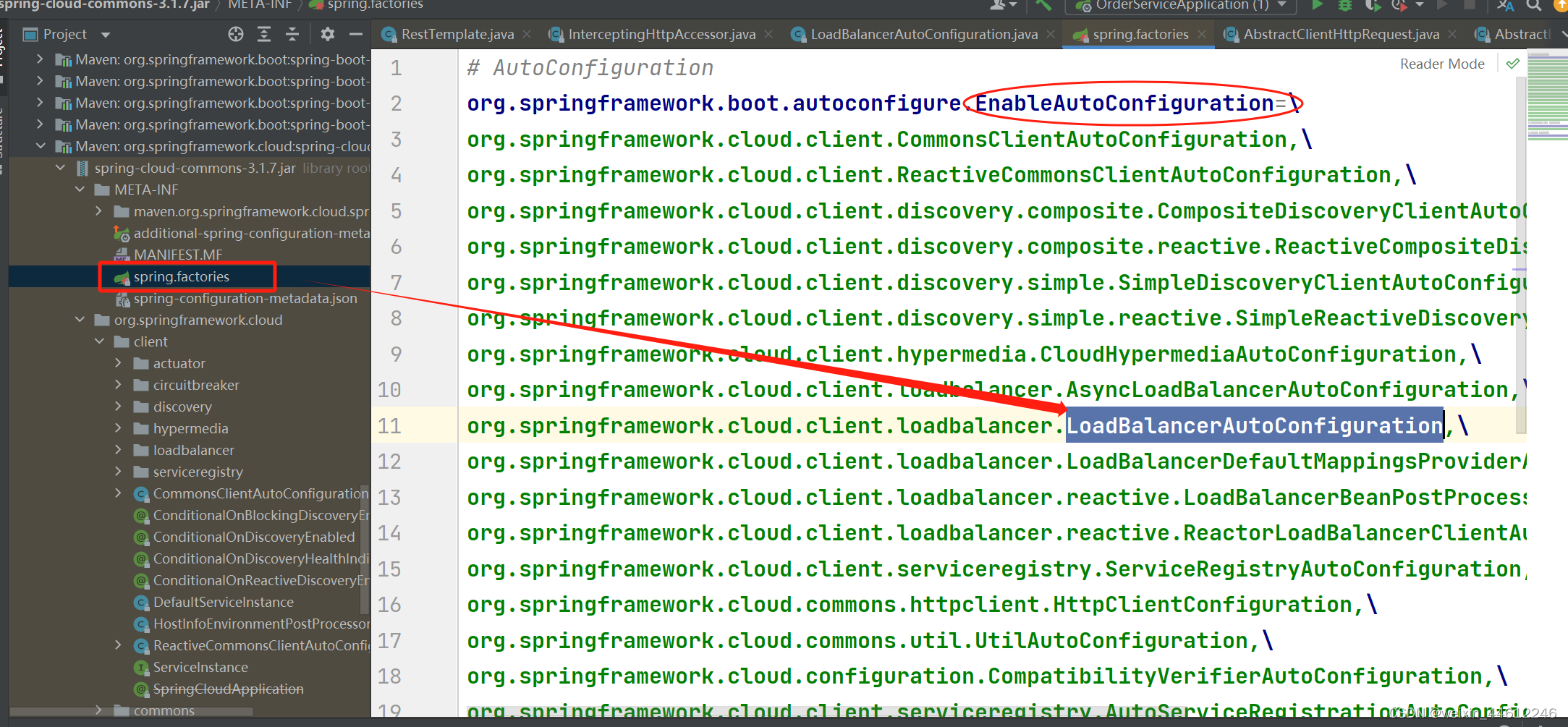接上一篇文章,案例代码也在上一篇文章的基础上。
在上一篇文章的案例中,我们创建了作为Eureka server的Eureka注册中心服务、作为Eureka client的userservice、orderservice。
orderservice引入RestTemplate,加入了@LoadBalanced注解,代码如下:
package com;@SpringBootApplication
@EnableEurekaClient
public class OrderServiceApplication {public static void main(String[] args) {SpringApplication.run(OrderServiceApplication.class);}@Bean@LoadBalancedpublic RestTemplate restTemplate(){return new RestTemplate();}}从而,我们实现了基于Eureka注册中心的微服务治理框架,在orderservice调用userservice的时候通过加了@LoadBalanced注解的RestTemplate实现了负载均衡。
今天的目标是:深入研究@LoadBalanced生效的底层原理。
@LoadBalanced是怎么实现负载均衡的?
我们要回答的第一个问题是,为什么@LoadBalanced能实现负载均衡?
我们从代码的源头一路追查下去…
orderservice通过RestTemplate实现对userservice的调用代码:
@Service
public class OrderService {@Autowiredprivate RestTemplate restTemplate;public String getOrder(){//通过userService获取user信息String url="http://userservice/user/getUser";System.out.println("url"+url);User user=restTemplate.getForObject(url,User.class);System.out.println(user);return user.getName();}
}
很容易的,我们需要有一个认知:这里访问的地址http://userservice/user/getUser只可能在Spring cloud服务治理环境下有意义,最终能访问到我们发布到本机上的userservice的如下服务:
1. http://localhost:8080
2. http://localhost:8081
3. http://localhost:8082
必定需要借助Spring Cloud的某一机制将http://userservice转换为上述地址之一。这个转换过程,也就是Spring Cloud的负载均衡机制。
跟踪getForObject:
@Override@Nullablepublic <T> T getForObject(String url, Class<T> responseType, Object... uriVariables) throws RestClientException {RequestCallback requestCallback = acceptHeaderRequestCallback(responseType);HttpMessageConverterExtractor<T> responseExtractor =new HttpMessageConverterExtractor<>(responseType, getMessageConverters(), logger);return execute(url, HttpMethod.GET, requestCallback, responseExtractor, uriVariables);}
调用到execute方法:
@Override@Nullablepublic <T> T execute(String url, HttpMethod method, @Nullable RequestCallback requestCallback,@Nullable ResponseExtractor<T> responseExtractor, Object... uriVariables) throws RestClientException {URI expanded = getUriTemplateHandler().expand(url, uriVariables);return doExecute(expanded, method, requestCallback, responseExtractor);}
doExecute方法:
@Nullableprotected <T> T doExecute(URI url, @Nullable HttpMethod method, @Nullable RequestCallback requestCallback,@Nullable ResponseExtractor<T> responseExtractor) throws RestClientException {Assert.notNull(url, "URI is required");Assert.notNull(method, "HttpMethod is required");ClientHttpResponse response = null;try {ClientHttpRequest request = createRequest(url, method);if (requestCallback != null) {requestCallback.doWithRequest(request);}response = request.execute();handleResponse(url, method, response);return (responseExtractor != null ? responseExtractor.extractData(response) : null);}catch (IOException ex) {String resource = url.toString();String query = url.getRawQuery();resource = (query != null ? resource.substring(0, resource.indexOf('?')) : resource);throw new ResourceAccessException("I/O error on " + method.name() +" request for \"" + resource + "\": " + ex.getMessage(), ex);}finally {if (response != null) {response.close();}}}
createRequest方法:
protected ClientHttpRequest createRequest(URI url, HttpMethod method) throws IOException {ClientHttpRequest request = getRequestFactory().createRequest(url, method);initialize(request);if (logger.isDebugEnabled()) {logger.debug("HTTP " + method.name() + " " + url);}return request;}
最关键的部分来了,就是这个 getRequestFactory()方法,在RestTemplate的父类InterceptingHttpAccessor中定义:
private final List<ClientHttpRequestInterceptor> interceptors = new ArrayList<>();public ClientHttpRequestFactory getRequestFactory() {List<ClientHttpRequestInterceptor> interceptors = getInterceptors();if (!CollectionUtils.isEmpty(interceptors)) {ClientHttpRequestFactory factory = this.interceptingRequestFactory;if (factory == null) {factory = new InterceptingClientHttpRequestFactory(super.getRequestFactory(), interceptors);this.interceptingRequestFactory = factory;}return factory;}else {return super.getRequestFactory();}}public List<ClientHttpRequestInterceptor> getInterceptors() {return this.interceptors;}
首先通过getInterceptor()方法检查是否有有拦截器,拦截器interceptors是由ClientHttpRequestInterceptor组成的一个list。如果有的话,就会创建InterceptingClientHttpRequestFactory、并且将拦截器interceptors送给InterceptingClientHttpRequestFactory工厂之后,返回工厂InterceptingClientHttpRequestFactory。
然后,方法调用返回到createRequest方法中,调用InterceptingClientHttpRequestFactory的createRequest方法,最终会调用到:
@Overrideprotected ClientHttpRequest createRequest(URI uri, HttpMethod httpMethod, ClientHttpRequestFactory requestFactory) {return new InterceptingClientHttpRequest(requestFactory, this.interceptors, uri, httpMethod);}
方法最终返回的是InterceptingClientHttpRequest,并且,会将工厂InterceptingClientHttpRequestFactory持有的interceptors传递给InterceptingClientHttpRequest对象:
protected InterceptingClientHttpRequest(ClientHttpRequestFactory requestFactory,List<ClientHttpRequestInterceptor> interceptors, URI uri, HttpMethod method) {this.requestFactory = requestFactory;this.interceptors = interceptors;this.method = method;this.uri = uri;}
之后返回到doExecute方法中,会调用InterceptingClientHttpRequest的父类AbstractClientHttpRequest类的execute方法、之后又转回到InterceptingClientHttpRequest类的executeInternal方法:
@Overrideprotected final ClientHttpResponse executeInternal(HttpHeaders headers, byte[] bufferedOutput) throws IOException {InterceptingRequestExecution requestExecution = new InterceptingRequestExecution();return requestExecution.execute(this, bufferedOutput);}
executeInternal方法创建了InterceptingClientHttpRequest内部类InterceptingRequestExecution对象之后,调用内部对象的execute方法。
查看内部类InterceptingRequestExecution,不难发现,他拿到了宿主类InterceptingClientHttpRequest的拦截器interceptors的迭代器:
private class InterceptingRequestExecution implements ClientHttpRequestExecution {private final Iterator<ClientHttpRequestInterceptor> iterator;public InterceptingRequestExecution() {this.iterator = interceptors.iterator();}@Overridepublic ClientHttpResponse execute(HttpRequest request, byte[] body) throws IOException {if (this.iterator.hasNext()) {ClientHttpRequestInterceptor nextInterceptor = this.iterator.next();return nextInterceptor.intercept(request, body, this);}else {HttpMethod method = request.getMethod();Assert.state(method != null, "No standard HTTP method");ClientHttpRequest delegate = requestFactory.createRequest(request.getURI(), method);request.getHeaders().forEach((key, value) -> delegate.getHeaders().addAll(key, value));if (body.length > 0) {if (delegate instanceof StreamingHttpOutputMessage) {StreamingHttpOutputMessage streamingOutputMessage = (StreamingHttpOutputMessage) delegate;streamingOutputMessage.setBody(outputStream -> StreamUtils.copy(body, outputStream));}else {StreamUtils.copy(body, delegate.getBody());}}return delegate.execute();}}}
然后在execute方法中首先遍历该迭代器iterator并调用迭代器对象ClientHttpRequestInterceptor的intercept方法。
拦截器ClientHttpRequestInterceptor就是实现负载均衡的关键所在,Spring正是在拦截器ClientHttpRequestInterceptor的intercept方法中,完成了负载均衡的实现:将请求中的服务名称比如本案例中的userservice、替换成了由Eureka注册中心下发下来的具体的userservice服务器(比如http://127.0.0.1:8081)
我们发现最关键的部分就是RestTemplate对象中的拦截器interceptors。
接下来的问题就是:interceptors是什么时候、怎么创建出来的?
拦截器的初始化
从RestTemplate的父类InterceptingHttpAccessor简单追踪一下,不难发现他的interceptors是通过setInterceptors方法赋值的,然后借助开发工具的帮助:

发现LoadBalanceAutoConfiguration调用了setInterceptors方法。
这个LoadBalanceAutoConfiguration的命名方式是不是很熟悉啊?我们前面分析过SpringBoot的自动配置,就是各种xxxxAutoConfiguration命名的类负责具体的自动配置任务的。
简单了解了下,LoadBalanceAutoConfiguration就是SpringBoot的自动配置类。我们找到LoadBalanceAutoConfiguration类在spring-cloud-commons包下,按图索骥,我们找到了包下的/META-INF/spring.factories文件:

因此我们知道,SpringBoot的自动配置机制会通过调用LoadBalanceAutoConfiguration类来完成LoadBalance的相关初始化工作。
所以我们接下来的工作就是要研究LoadBalanceAutoConfiguration。
LoadBalanceAutoConfiguration
第一步,从LoadBalanceAutoConfiguration类的源码知道他要通过restTemplateCustomizer方法加载一个RestTemplateCustomizer对象,方法需要一个参数LoadBalancerInterceptor:
@Bean@ConditionalOnMissingBeanpublic RestTemplateCustomizer restTemplateCustomizer(final LoadBalancerInterceptor loadBalancerInterceptor) {return restTemplate -> {List<ClientHttpRequestInterceptor> list = new ArrayList<>(restTemplate.getInterceptors());list.add(loadBalancerInterceptor);restTemplate.setInterceptors(list);};}
先看一眼RestTemplateCustomizer类,只有一个customize方法,该方法有一个参数RestTemplate:
public interface RestTemplateCustomizer {void customize(RestTemplate restTemplate);}
这个customize方法已经在restTemplateCustomizer方法中通过lamda表达式定义出来了,代码逻辑很简单:
就是要将LoadBalancerInterceptor拦截器对象通过调用RestTemplate的setInterceptors方法加入到RestTemplate的interceptors中!
似乎快要摸到开关了!!!
那么我们现在又冒出了以下几个问题:
- 这个LoadBalancerInterceptor从哪里来?
- RestTemplate从哪里来?
- 什么时候调用这个已经注入到Spring Ioc容器中的RestTemplateCustomizer的customize方法?
第1、第2两个问题其实很简单。看代码:
@Configuration(proxyBeanMethods = false)@Conditional(RetryMissingOrDisabledCondition.class)static class LoadBalancerInterceptorConfig {@Beanpublic LoadBalancerInterceptor loadBalancerInterceptor(LoadBalancerClient loadBalancerClient,LoadBalancerRequestFactory requestFactory) {return new LoadBalancerInterceptor(loadBalancerClient, requestFactory);}...
}
LoadBalancerAutoConfiguration类中有一个静态配置类LoadBalancerInterceptorConfig,通过loadBalancerInterceptor方法注入了LoadBalancerInterceptor 对象,创建对象的时候通过参数注入了loadBalancerClient和LoadBalancerRequestFactory。
第2个问题,RestTemplate的注入,其实是我们从应用层通过@Bean注入的,同时加了@LoadBalanced注解。
现在我们来回答第3个问题:
什么时候调用这个已经注入到Spring Ioc容器中的RestTemplateCustomizer的customize方法?
比前两个问题稍稍复杂了一点:
@LoadBalanced@Autowired(required = false)private List<RestTemplate> restTemplates = Collections.emptyList();@Beanpublic SmartInitializingSingleton loadBalancedRestTemplateInitializerDeprecated(final ObjectProvider<List<RestTemplateCustomizer>> restTemplateCustomizers) {return () -> restTemplateCustomizers.ifAvailable(customizers -> {for (RestTemplate restTemplate : LoadBalancerAutoConfiguration.this.restTemplates) {for (RestTemplateCustomizer customizer : customizers) {customizer.customize(restTemplate);}}});}
首先看到标注了@Autowire和@LoadBalanced注解的RestTemplates列表的注入,意思是: 如果有加了@LoadBalanced注解的RestTemplates bean的话,就自动装配到restTemplates 变量中。
之后,通过loadBalancedRestTemplateInitializerDeprecated方法注入了一个SmartInitializingSingleton,我们知道SmartInitializingSingleton在装配到Spring Ioc之后会调用他的afterSingletonsInstantiated()方法。这里注入的SmartInitializingSingleton通过lamda实现了afterSingletonsInstantiated()方法,代码逻辑:通过方法参数打包注入到Ioc容器中的RestTemplateCustomizer(前面讲过了,他已经注入到IoC容器中了)到restTemplateCustomizers中,然后遍历restTemplates(这个list在前面说过了,已经把我们通过@Bean和@LoadBalanced注解的RestTemplate对象注入进来了)、针对每一个RestTemplate再遍历restTemplateCustomizers中的RestTemplateCustomizer对象,逐个调用他的customize方法。
OK!对于@LoadBalanced注解从应用、到初始化、生效机制,我们就分析清楚了。
最后还遗留两个小问题,初始化和应用两端各一个:初始化过程中的装配到loadBalancerInterceptor对象中的LoadBalancerClient具体是什么对象、什么时候注入的?应用端最终的负载均衡策略、负载均衡实现逻辑,我们还没具体分析。
下一篇文章解决上述两个问题。
)


:路由器基础)

之开发者配置一)


,JSP(九大内置对象)、Servlet(生命周期)了解)










)